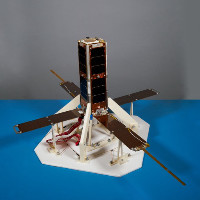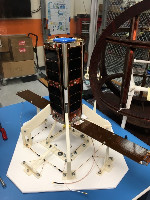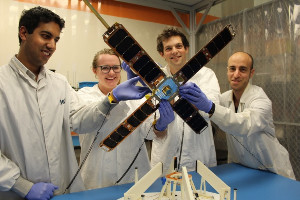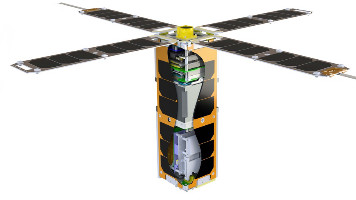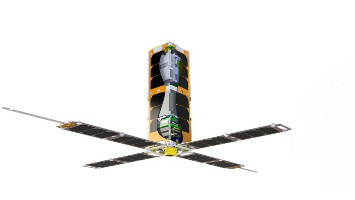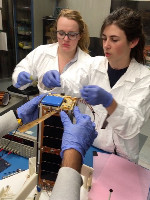| Satellite name | DODONA (GSky-1, GalacticSky-1, La Jument) |
|---|---|
| Spacecraft type | CubeSat |
| Units or mass | 3U |
| Status | Operational? (No confirmation found as of 2022-05-26, but object is identified in Space-Track) |
| Launched | 2022-01-13 |
| NORAD ID | 51084 |
| Deployer | QuadPack (XL) [ISISpace] |
| Launcher | Falcon 9 (Transporter-3) |
| Deployment | Deployed from D-Orbit ION on 2022-02-15 |
| Organization | University of Southern California |
| Institution | University |
| Entity type | Academic / Education |
| Nation | US |
| Manufacturer | AIVT by University of Southern California |
| Partners | Lockheed Martin, Vector Space, NASA, Air Force Research Laboratory (AFRL) |
| Oneliner |
Software-defined satellite to dynamically change their missions on orbit. |
| Description |
Students at University of Southern California's Information Sciences Institute will build the satellites and integrate them with Lockheed Martin’s SmartSat mission payload. Various payloads and demonstrate various control and communications techniques. A new B-Dot control algorithm will be demonstrated for minimum power control using torque rods, a rotating multi-packetized beacon transmission source will prove backup to the primary communications system, and data store and forward software will be demonstrated for non-consistent ground contacts. The Cubesat bus is a MISC-2, a sister of the Aeneas design and will use the same flower petal configuration for primary solar array power. Create an application and host it on an existing satellite or across an ad-hoc constellation. Goal to bring the promise of space-based technologies to a much larger pool of entrepreneurs who don't need to be space experts. CrossTrac Precision Timing Board (PTB) - Combines the short-term precision of an atomic clock with the long-term stability of a GPS receiver to provide users with a programmable precision time reference. The test data from PTB ground and flight demonstrations have been purchased by NASA. Cateni Processor/Sensor Flight Board (PSFB) - Integrates advanced command and data processing components with ethernet interfaces for IP based communications between the vehicle and payloads, two Teledyne radiation dosimeters (one shielded by VSRS and the other exposed to space), and integrated GPS with the groundbreaking MEMs integrated 6-axis MotionTracking device that combines a 3-axis gyroscope, 3-axis accelerometer, and a Digital Motion Processor. TUI Versatile Structural Radiation Shielding (VSRS) - VSRS is a novel, 3D-printed radiation shielding technology developed by Tethers Unlimited under Air Force Small Business Innovation Research (SBIR) funding to provide a lightweight, customizable, and cost-effective solution to enable commercial off the shelf (COTS) electronics to operate reliably in the space radiation environment. Primary research goal is creating a transmission system between the student run ground station and the spacecraft in orbit. For the program, four La Jument nanosatellites -- the first launching later this year -- will use Lockheed Martin’s SmartSat™ software-defined satellite architecture on both their payload and bus. SmartSat lets satellite operators quickly change missions while in orbit with the simplicity of starting, stopping or uploading new applications. The system is powered by the NVIDIA® Jetson™ platform built on the CUDA-X™ capable software stack and supported by the NVIDIA JetPack™ software development kit (SDK), delivering powerful AI at the edge computing capabilities to unlock advanced image and digital signal processing. Dodona carries Lockheed Martin’s software-defined La Jument payload which will help space qualify a number of Artificial Intelligence (AI) and Machine Learning (ML) technologies. In particular, on orbit, the La Jument payload will demonstrate how Lockheed Martin’s SmartSat™ software-defined satellite architecture can control a lowcost camera and perform onboard SuperRes™ upscale processing of collected image data of the Earth’s surface. SmartSat™ allows users to expand satellite capabilities and change missions on orbit. |
| Notes |
Spacecraft was ready for launch end of 2019, but Vector Space went bankrupt in 2019 and sold satellite technology to Lockheed Martin. |
| Sources | [1] [2] [3] [4] [5] [6] [7] |
| Photo sources | [1] [2] [3] [4] |
| COTS subsystems |
|
| Subsystems sources | [1] |
| Keywords | Software-defined satellite, Machine Learning AI |
| On the same launch |
|
Last modified: 2023-06-09
